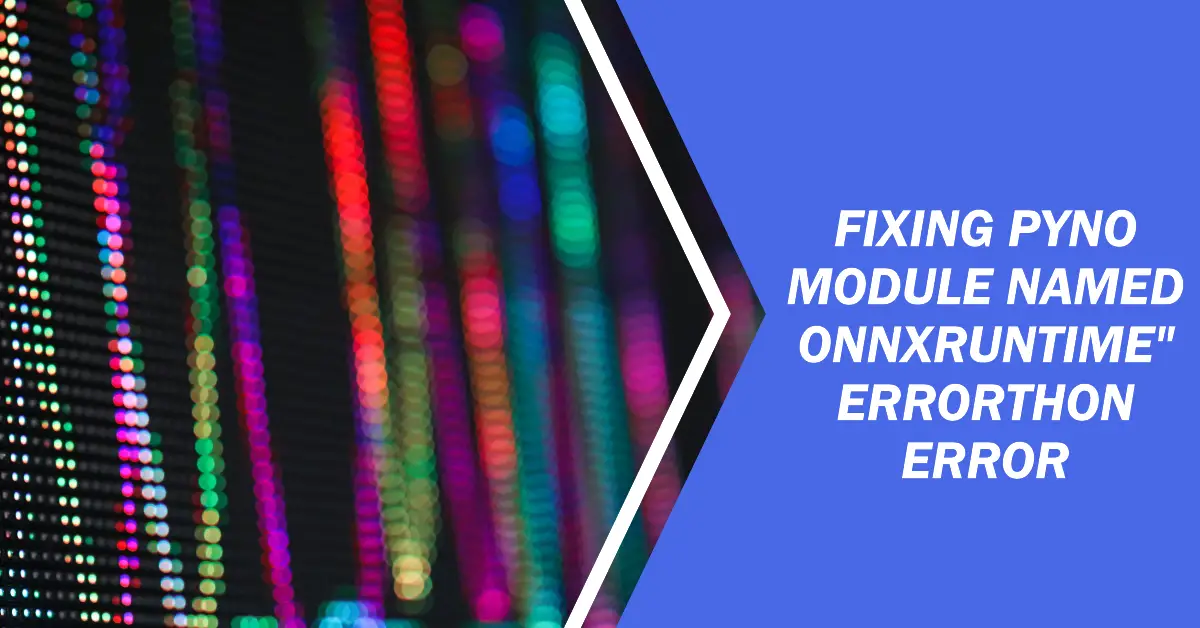Apple 2024 MacBook Air 13-inch Laptop with M3 chip: 13.6-inch Liquid Retina Display, 8GB Unified Memory, 256GB SSD Storage, Backlit Keyboard, 1080p FaceTime HD Camera, Touch ID; Starlight
10% OffIntroduction
As a beginner in the world of programming, encountering errors can be a daunting experience. One such error that often puzzles newcomers is the “No Module Named onnxruntime” error. This error typically arises when working with deep learning frameworks like PyTorch or TensorFlow, and it can be frustrating to resolve without proper guidance.
In this comprehensive guide, we’ll dive deep into understanding the root cause of this error and provide step-by-step solutions to fix it. Whether you’re a seasoned developer or just starting, this article will equip you with the knowledge and tools to tackle this issue head-on.
What is ONNX Runtime?
Before we delve into the solutions, let’s first understand what ONNX Runtime is and why it’s essential for deep learning projects. ONNX (Open Neural Network Exchange) is an open-source format for representing deep learning models, enabling interoperability between various frameworks and hardware platforms.
ONNX Runtime, on the other hand, is a high-performance inference engine that can efficiently run ONNX models on various platforms, including CPUs, GPUs, and specialized accelerators. It’s widely used in production environments to optimize and accelerate the inference process of deep learning models.
Common Causes of the “No Module Named onnxruntime” Error:
- Missing Dependencies: The primary cause of this error is the absence of the necessary dependencies required to run ONNX Runtime. This can happen when working on a new project or a different environment where the required packages are not installed.
- Environment Conflicts: Sometimes, the error may occur due to conflicts between different Python environments or package versions. For example, if you have multiple Python installations or virtual environments with different package versions, it can lead to this error.
- Incorrect Installation: In some cases, the error may arise due to an incorrect or incomplete installation of ONNX Runtime or its dependencies.
Fixing the “No Module Named onnxruntime” Error:
Now that we understand the potential causes, let’s explore the solutions to fix this error.
Solution 1: Installing ONNX Runtime via pip
The simplest solution is to install the ONNX Runtime package using pip, the Python package installer. Follow these steps:
Open your terminal or command prompt.
Ensure that you have the latest version of pip installed by running the following command:
python -m pip install --upgrade pipInstall ONNX Runtime by running the following command:
pip install onnxruntimeThis command will install the ONNX Runtime package and its dependencies.
Solution 2: Installing ONNX Runtime with Conda
If you’re using Anaconda, you can install ONNX Runtime through the Conda package manager. Follow these steps:
Open your Anaconda Prompt or terminal.
Create a new Conda environment or activate an existing one by running the following command:
conda create --name your_env_name python=3.x conda activate your_env_nameReplace your_env_name with the desired name for your environment, and 3.x with the Python version you want to use.
Install ONNX Runtime by running the following command:
conda install -c conda-forge onnxruntimeThis command will install the ONNX Runtime package and its dependencies in your specified Conda environment.
Solution 3: Resolving Environment Conflicts
If you’re experiencing conflicts between different Python environments or package versions, follow these steps:
- Identify the environment where you want to install ONNX Runtime.
- Activate the desired environment using the appropriate command for your system (e.g.,
conda activate your_env_namefor Conda environments orsource your_env_path/bin/activatefor virtual environments). - Once the environment is activated, install ONNX Runtime using one of the methods mentioned above (either pip or Conda).
Solution 4: Verifying the Installation
After installing ONNX Runtime, you can verify the installation by running the following Python code snippet:
import onnxruntime print(onnxruntime.<strong>version</strong>)If the installation was successful, you should see the version number of the installed ONNX Runtime package printed to the console.
Solution 5: Updating ONNX Runtime (if already installed)
If you have an older version of ONNX Runtime installed and encounter issues, you can update it to the latest version by running the following commands:
For pip:
pip install --upgrade onnxruntimeFor Conda:
conda update onnxruntimeCommon FAQs:
Q: Can I install ONNX Runtime without ONNX?
A: Yes, you can install ONNX Runtime without installing ONNX. ONNX Runtime is a separate package that provides the inference engine for running ONNX models.
Q: Do I need to install ONNX Runtime for every deep learning framework?
A: No, ONNX Runtime is a framework-agnostic package. Once installed, it can be used with any deep learning framework that supports ONNX model format, such as PyTorch, TensorFlow, and others
Q: Can I use ONNX Runtime on different hardware platforms?
A: Yes, ONNX Runtime is designed to be hardware-agnostic and can run on various platforms, including CPUs, GPUs, and specialized accelerators like TPUs or VPUs, provided that the necessary drivers and libraries are installed.
Q: How can I check if ONNX Runtime is using my GPU for acceleration?
A: You can check if ONNX Runtime is utilizing your GPU by inspecting the output of the following Python code snippet:
import onnxruntime
providers = onnxruntime.get_available_providers()<br>print(providers)Conclusion:
The “No Module Named onnxruntime” error can be frustrating, but with the right understanding and approach, it can be resolved. By following the solutions outlined in this guide, you’ll be equipped to install ONNX Runtime successfully and overcome this common hurdle.
Remember, troubleshooting is an integral part of the programming journey, and every error serves as an opportunity to learn and grow. Embrace the challenges, and don’t hesitate to seek help from online resources or communities when needed.
Happy coding!

Greetings! I am Ahmad Raza, and I bring over 10 years of experience in the fascinating realm of operating systems. As an expert in this field, I am passionate about unraveling the complexities of Windows and Linux systems. Through WindowsCage.com, I aim to share my knowledge and practical solutions to various operating system issues. From essential command-line commands to advanced server management, my goal is to empower readers to navigate the digital landscape with confidence.
Join me on this exciting journey of exploration and learning at WindowsCage.com. Together, let’s conquer the challenges of operating systems and unlock their true potential.













